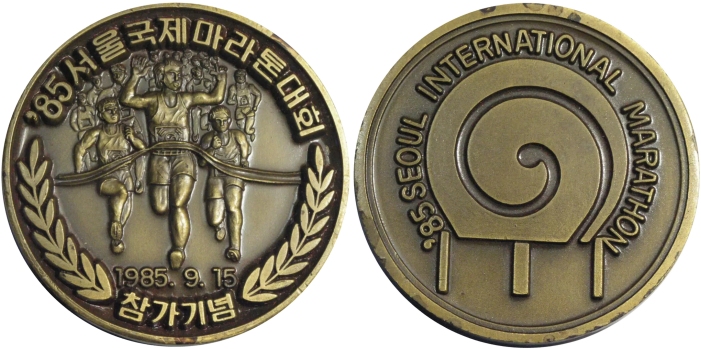
The March 1st 1919 Movement forced the Japanese to rethink their administration of Korea. Part of Japan’s new, so-called Cultural Rule 文化統治 (문화통치) was the creation and publication of Korean private newspapers. They received about 10 applications. On January 6, 1920, the Japanese approved the creation of only three newspapers: the Dong-A Ilbo 동아일보 (東亞日報), the Chosun Ilbo 조선일보 (朝鮮日報), and Sisa Shinmun 시사신문 (時事新聞 Current Affairs Newspaper). Two of these newspapers are heavily involved with Korean Marathons.
The Dong-A Ilbo
One of these newspapers, the Dong-A Ilbo 동아일보 (東亞日報) was launched on April 1, 1920. Over the years, the Dong-A Ilbo has hosted numerous sporting, educational and cultural events. These include: the All-Chosŏn Women’s Tennis Tournament 전조선여자정구대회 in July 1923, the Student Speech Contest 학생웅변대회 in October 1924, the Donga Spring Literary Contest 동아신춘문예 in 1925, the Four Club Baseball Federation Match (Baeje 배제, Jungang 중앙, Whimun 휘문, Gyeongshin 경신) in August 1926, the Swimming Competition 수영경기대회 in September 1929, etc. After Korea’s liberation, the newspaper continued to contribute to the development of talent in various fields.
In 1931, the newspaper hosted the first Dong A Marathon 동아마라톤대회. The marathon was acquired by Dong-A Ilbo in 1939. However, the races were discontinued in August 1940 due to the Japanese involvement in WWII. The marathon continued to languish during the American occupation (1945-48), the early liberation period and finally due to the Korean War. It was revived as the 23rd Gyeonggi-do Short-Marathon in 1953. Until 1964, all the Marathons were referred to as Semi-Marathons or Short-Marathons because they were laid out as 25 km races instead of the standard 42.2 km (26.22 mi). In 1982, KBS began broadcasting the event and hosting the Seoul International Marathon. In 1985, Yu Jae-seong 유재성 won in the men’s competition (2:15:48) and Im Un-ju 임은주 won the women’s competition (2:45:06).
Over the years, there have been numerous medals to commemorate the Seoul Marathon.
The Choson Ilbo
The Chosŏn Ilbo sponsors the largest marathon in Korea, the Chuncheon Marathon 춘천마라톤. It is nicknamed the ‘Legend of Autumn’ 가을의 전설.
The Chosun Ilbo first established the marathon on October 27, 1946, exactly 10 years after Son Ki-chung 손기정 (孫基禎) won the Gold Medal in the marathon at the 1936 Berlin Olympics. Its purpose was to promote national unity and spirit amid the excitement of liberation. This first marathon was a short-marathon. The following year, the race was upgraded to the ‘1st Chosun Ilbo Marathon in Commemoration of Son Kee-chung World Championship’ 손기정 세계제패기념 제1회 조선일보마라톤대회. Since then, it has led the Korean marathon world for over half a century. The Chosun Ilbo Marathon was reborn as the ‘Chosŏn Ilbo Chuncheon International Marathon’ 조선일보춘천국제마라톤 on October 28, 1995. The Chuncheon Marathon received gold level from the World Athletics Federation in 2013, and was registered as one of the world’s top 8 marathons in terms of number of finishers in 2004.
Over the years, there have been numerous medals to commemorate the Chuncheon Marathon. However, I have been unable to find an early medal from this event.
The Sisa Shinmun
The first Sisa Shinmun newspaper was founded on January 1, 1910, just before the Japan-Korea Annexation. It was criticized by the public for its pro-Japanese attitude. Because of this, readers turned away from the paper and on May 8, 1910, it was forced to suspend operations due to financial difficulties. Min Won-sik 민원식, a well-known Japanese collaborator, founded the second Sisa Shinmun on April 1, 1920, the same day as the Dong-A Ilbo began publishing. Because of its pro-Japanese tone, the newspaper failed to gain popularity among readers. Min Won-sik went to Japan to petition for Korea’s right to vote. During his trip, on February 16, 1921, he was assassinated by Yang Geun-hwan 양근환 (梁槿煥 May 1894 – September 1950, also known as Yang Tae-hwan 梁泰煥 and Yang Sam-seong 梁三成). Subsequently, Sisa Shinmun gave up being a daily newspaper and was re-launched as a monthly magazine, the Sisa Review 시사평론.
On June 30, 1921, Yang Geun-hwan was sentenced to life imprisonment at the Tokyo District Court. He was released from prison on February 11, 1933. During the Korean War, he was captured by retreating North Korean troops. He was sentenced to death at a people’s court in Paju-si, Gyeonggi-do for his anti-communist activities, and was executed around September 15, 1950. In 1980, he was posthumously awarded the Order of National Foundation, National Medal 국민장 (國民章). A third-class medal that has since been renamed the Independence Medal 독립장 (獨立章).
